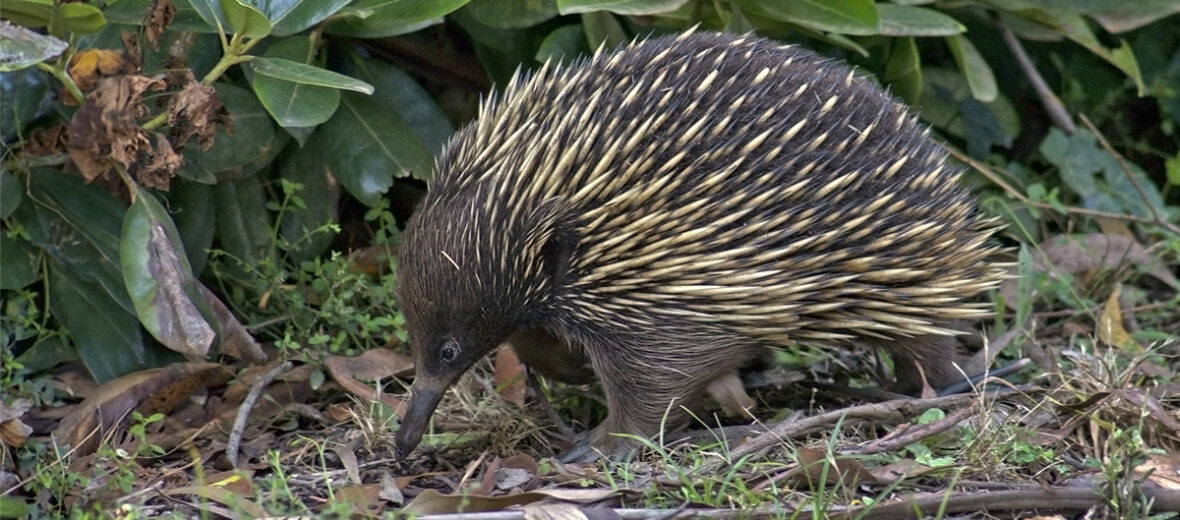
The short-beaked echidna, aka common echidna, short-nosed echidna, or spiny anteater, can be found throughout Australia, into Papua New Guinea, and Tasmania. They tolerate a wide range of habitats like Australian desert habitats, coastal forests, dry inland areas, heathlands, meadows, woodlands, agricultural areas, and the outer regions of urban areas. They face the threats of overhunting in New Guinea as well as capture for ceremonial purposes throughout their ranges. But they have a stable population and are thus listed as Least Concern by the IUCN.
First the Stats…
Scientific name: Tachyglossus aculeatus
Weight: Up to 15.4 lbs.
Length: Up to 18 inches, plus up to a 3 inch snout
Lifespan: Up to 49 years
Now on to the Facts!
1.) These critters are solitary and only come together to mate.
2.) When the weather gets too warm, they become nocturnal (active at night), during colder months or at higher elevations, they are more diurnal (active during the day).
3.) Not only do they hibernate during the really cold portions of winter, but they also enter into periods of torpor (periods of lower body temperature, heart rate, breathing rate, and metabolic rate).
4.) With their powerful forelimbs and sharp claws, they are able to easily destroy logs, ant hills, and termite mounds.
5.) Echidnas utilize specially evolved electro sensors located in the tip of their snout to find food.
But wait, there’s more on the short-beaked echidna!
6.) Even though they can’t roll into a ball, like a hedgehog, they do fold themselves almost in half to shield their soft belly, revealing only their sharp spines as defense against predators.
7.) They also dig burrows at great speed, especially if threatened.
Did you know…?
Echidnas and platypuses are the only living group of mammals to lay eggs, and are called monotremes.
8.) Other defense mechanisms are urinating which gives off a foul odor, and they have the remnants of a single spur on each hind leg that can also be used to stab predators with.
9.) Their diet consists of ants, beetle grubs, termites, and worms.
10.) Short-beaked echidnas are polygynous (1 male mates with multiple females).
But wait, there’s still more on the short-beaked echidna!
11.) During mating season, a line of males, called an echidna train, will follow a single female with the hopes of being able to mate with her.
12.) Mating occurs from June – August.
Did you know…?
They may waddle when they walk, but these critters are excellent swimmers, able to navigate slower moving rivers, lakes, and beaches; and they’re even able to swim in the sea.
13.) Females are gravid (pregnant) for up to 23 days before laying her single egg that hatches in up to 23 days.
14.) The egg is incubated in the mother’s pouch until the baby, called a puggle, is hatched.
15.) The puggle is only .6 inch long.
But wait, there’s still a little more on the short-beaked echidna!
16.) A puggle will stay in it’s mother’s pouch for up to 3 months, until their spines develop.
17.) Weaning takes place at about 7 months of age, and after 1 year, they will leave their mother’s protection to start life on their own.
Did you know…?
The short-beaked echidna is on Australia’s 5 cent coin.
18.) When swimming, only their snout and some spines are visible.
19.) During hotter days, short-beaked echidnas seek the shelter of shady locations as they do not pant or sweat. They may also seek out water sources to cool down in.
20.) Each spine is connected to a series of small muscles that can move the spines in various directions.
But wait, there’s just a tad more on the short-beaked echidna!
21.) Echidnas have the intelligence of a house cat.
22.) Female echidnas deposit milk via 2 areola patches: small, furry regions connected to their mammary glands. The puggle suckles milk directly from its mother’s skin.
Did you know…?
While echidnas and hedgehogs may look similar, they are markedly different. This is known as convergent evolution.
23.) With their powerful, thick limbs, these critters are able to move items that can weigh as much as 30+ lbs.!
24.) Their hind feet face backwards.
25.) Echidnas have a digestive system, but they lack a stomach.
Now a Short Short-Beaked Echidna Video!
Be sure to share & comment below! Also, check out the Critter Science YouTube channel. Videos added regularly!
Want to suggest a critter for me to write about? Let me know here.
Some source material acquired from: Wikipedia & IUCN
Photo credit: iNaturalist



